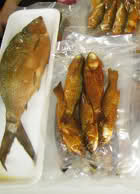A typical Filipino breakfast usually has fish in it. From the traditional way of simply frying, boiling, or blanching fish, Filipinos have learned other ways of making a more delightful means of preparing and preserving fish.

Fish and marine products are now prepared and processed by either smoking, drying, salting, or canning.
In the Philippines, smoked fish locally known as tinapa is very popular and has become part of the Filipino meal, especially during breakfast.
However, tinapa relatively possesses a characteristic of being smoky and with a short shelf life. In this context, a study on smoked fish was conceptualized and spice-curing technology was developed by the Southern Luzon State University (SLSU) in Lucban, Quezon headed by Prof. Delia Babilonia.
This research aimed at increasing the shelf life of tinapa and at the same time improving the earnings of the adopters/processors by providing consumers better smoked fish product that ensures sustainability of market preference of the consumers.
Postharvest and processing procedures of spice-curing technology for smoked fish
Medium-size Indian sardines or “Tamban” with intact scales and belly are washed with clean water and drained. Spice-curing solution is prepared by dissolving 250 grams of table salt and 100 g of powdered spices (onion, garlic, chili, and black pepper) in 1 gallon of water. This is divided into two equivalent portions, for soaking and cooking of fish.
Fish are then soaked in the solution for 5 hours with occasional agitation. Cured fish are removed from the solution and arranged in bamboo trays and allowed to drain for 30 minutes. The fish are then cooked in boiling solution by dipping the tray for 10-15 minutes under low fire. The cooked fish are maintained in the tray and air-dried for 1-2 hours.
“This is necessary for pellicle formation, which is essential for better color development,” Ms. Babilonia explained. After air-drying, fish are arranged in the smoking trays and loaded in the pre-heated smokehouse and smoked for 2 hours or when the fish turn golden brown.
To make the product more attractive to consumers, a new packaging style is more hygienic than newspaper or magazine was introduced.
Marketing approach
Product displays and exhibition within and outside the SLSU helped the group promote and market their product. SLSU also developed Teknokomiks distributed to Municipal Agricultural Officers (MAOs) of the towns of Quezon to enhance awareness towards the developed technology on spiced-cured smoke fish.
Lecture-demonstrations were held to familiarize fish processors with the process. Marketing of the product at present is exclusive and selective. Delivery of the product is based on the orders of the prospective buyers.
The SLSU is also providing the technology to individual and association of fish processors and other rural organizations for livelihood purposes as part of its extension program.
Personal note
Ms. Babilonia fully acknowledges Director Nicomedes Eleazar of DA-BAR through the National Technology Commercialization Program (NTCP) and Dr. Cecilia N. Gascon, president of Southern Luzon State University for their support to the project. “Through granting of the needed financial assistance, the dissemination of the technology to the end-users became possible,” she added.
She considers the NTCP as one important component in postharvest/processing technologies. “Technologies are developed to address problems. Most often, people who produce and market their commodities are the ones facing problems in terms of proper postharvest handling. Processing technology is important to fill in the gaps and make the process more scientific,” Ms. Babilonia stressed.
According to her, technologies generated must be socialized so that people will benefit from it. “DA-BAR NTCP facilitates commercialization of technologies and made these available to the end-users who are the farmers and fisherfolk. The agency ensures that activities are operationalized through financial and technical assistance. This realizes the objective of BAR to bring mature technology to local level and to modernize activities in agriculture and fisheries,” she added.
In the coming years, Babilonia envisions that local fish processors even in the remotest areas can produce smoked and dried fish products in competitive and export quality. “With the continuous R&D in fish smoking and drying, tuyo and tinapa will not only be a good viand for the low income members of the community but also part of the diet of people at all levels of our society,” she averred.
The industry on locally-produced fish products is not hard to achieve. Sooner than we think, these will be penetrating both the local and international markets. This is the reason why individuals are going into developing studies on fish processing for creating business and income-generating livelihood.
Source: Ma. Eloisa E. Hernandez – bar.gov.ph January-March 2008 Volume 10 Issue No. 1
Photo: bar.gov.ph



Tinapa! Wow! I love that! Very good for breakfast. Try it with tomatoes on the side. I don’t know why but I seem to be addicted to that Filipino food… Smoked fish! Hmmm, yummy!
Tinapa is still my favorite Filipino dish, eat it with sliced tomatoes and onions! hmmm..yum! it’s a must try!
visit hurricane attorneys @ http://www.hurricanefirm.com
Love the taste of Tinapa! Delicious! Other nationalities should try it. Surely they’ll also love it like me.
Tinapa is really good tasting! My Canadian friend visited Philippines and he let me tried it. Good! Looking forward to taste it again.
where can i buy a smoke house for my smoked fish?i need one,please help me.
I tried tinapa two years ago when I visited Philippines and I can say that it is very delicious. Philippines got a yummy delicacy and guest should try this one. Good to hear that they are promoting this one.
Smoked fish I believe is one of the products Philippines should be proud of. I believe this food is only local in the Philippines. It is great news that they are trying to promote their local food. Every country has their own special delicacy that they should be proud of. I’m thinking of visiting Philippines and try one of these smoked fishes.
It’s great that they are trying to promote tinapa and that they are providing technology to enhance it’s productivity. I’ve tried one when I first visited Philippines last summer and it’s really delicious.
Certainly tinapa is one of the delicacies that you should try whenever you are in the Philippines, your vacation will never complete without trying that out..It’s really delicious..
Hey I love tinapa! My mom never forget to buy every grocery. Truly Filipino. Whenever I went home in the Philippines It’s the first thing I would always ask for.
Tinapa is very delicious. It’s one of the many products that Philippines can be very proud of. It’s good to know that Filipino foods are recognized and being developed.
Very sound business idea. thanks..
This spice-curing technology will definitely help a lot of people especially the masses because as you say tinapa has already become popular and part of the filipino meal.
something useful information sharing and great content.